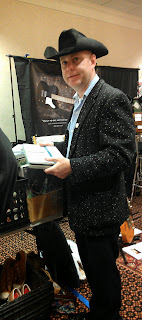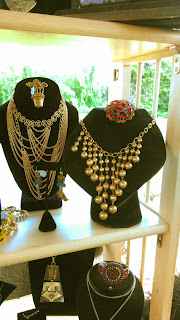As a trade member
of the Vintage Fashion Guild I am part of a large community of vintage fashion professionals.
All our members are passionate about vintage and work hard to maintain integrity
in our businesses. We are constantly
fact checking the history of our merchandise to make sure our goods are
properly represented. Whenever we are stumped about something we turn to each
other for answers and 99% of the time someone is able to help. Jonathan Walford
is a long time VFG member and one of our most knowledgeable. He is always
generous with information and never ceases to amaze me. He has written a number
of books (which I highly recommend) on vintage fashion and recently opened the Fashion History Museum in Ontario, Canada.
I asked Jonathan if he would agree to an interview for my blog so you could all
meet the man behind the museum and hear his story.
-When did your passion for the history of fashion and textiles begin? Did
you begin as a collector or a historian?
My
fascination with historical dress began when I was a kid. My favourite movies were
historically set films like: Chitty Chitty Bang Bang, The Great Race, and
Thoroughly Modern Millie. I remember crying myself to sleep because my parents
wouldn’t let me stay up to watch the Six Wives of Henry VIII on TV, I must have
been ten at the time. I began collecting soon after I started working at a museum
called Heritage Village in Burnaby, B.C. in the summer of 1977. I was given a
collarless shirt to wear as my costume and I figured I could do better than
that and began combing the vintage clothing stores of Gastown (the old heritage
district of Vancouver) for starched collars, knitted ties, and straw boaters.
By the end of the year I was receiving gifts from friends and family members
and putting most of my paycheque into buying the oldest pieces of antique
clothing I could find. My first dress purchase was a black net dress from the
mid 1890s.
-Tell us a little about your journey in the field and how it evolved over
time.
When I
began collecting, vintage clothing stores were still being run by Hippies who
had started their shops in the late 1960s. By 1980 the Punks and New Wavers
were buying old clothes and the stock in vintage shops shifted from Edwardian
underwear and 30s chiffons to 1950s prom dresses, stiletto-heeled shoes, and
leather motorcycle jackets.
I used my
collection for producing lectures and fashion shows in the 80s and 90s as a
sideline to my museum career. In 1987 I landed the curatorial job for the Bata Shoe Museum collection in Toronto. The museum was
not yet open to the public and its collection was held in the basement of the
Bata shoe company headquarters. With the help of a healthy acquisitions budget,
I was able to transform that collection into the internationally important
institution the Bata Shoe Museum has become today. In 1999 I had done all I
could at Bata and it was time to move on. As a freelance curator I phased out
my fashion shows and instead began creating travelling exhibitions for museums.
My first exhibition of 1960s paper dresses debuted in Montreal in the summer of
2001. In 2004 my partner Kenn was taking a leadership course and took the idea
of creating a fashion museum as a project for his course. By the end of that
year we had founded the Fashion History Museum. Five years later, in 2009, the
museum received its charitable status, which qualified us to offer tax receipts
for donations and brought us to the next hurdle – finding a home for the
museum.
-Your books are beautiful and contain a wellspring of knowledge. They must
represent countless hours of painstaking research and appear to be a true labor
of love. Could you talk a bit about this?
Even
though I had written numerous exhibition texts and museum catalogues, I didn’t
consider myself a writer. I have no patience for reading fiction and most
academic treatises are mind numbingly dull. I love ‘I was there’ memoirs. I
want to read what people thought at the time about what they wore and why they
thought it was beautiful or ugly. That information comes to us mostly from
period accounts, ranging from private diaries to magazine articles. While I was
writing the text for the 1960s paper dress exhibition I came across an archive
of period news clippings on the topic. The public reaction about paper clothing
in the 1960s ran the gamut from ‘innovative wave of the future’ to ‘the
stupidest fashion ever invented.’ I turned this research into the book ‘Ready
to Tear’, which doubled as a catalogue to accompany the same-named exhibition.
While looking for a publisher for the catalogue, Thames and Hudson rejected the
paper dress book for being intended for too specific a market, but asked if I
could write a shoe book instead – something I had wanted to do when I was still
at Bata. That turned into a three-book contract: The Seductive Shoe, Forties
Fashion, and Shoes A-Z. and I am now on my fourth book: Sixties Fashion, which
is coming out this October.
The
Internet has made researching these books possible. It would have taken years
and endless trips to libraries and archives to find what I can get now in the
comfort of my own home. With every passing year the access to obscure
publications increases, which makes the books feasible.
-The whole concept of creating a museum from scratch simply boggles my
mind, yet you and Ken did just that. I am intrigued to learn about your journey
from idea to reality in this venture.
We originally moved to Cambridge, Ontario in 2007
because a potential site for our museum was available. That plan didn’t pan out
but we liked the town and stayed. Three months ago we were given the
opportunity of a space to set up the museum that we grabbed because we had to
take a leap of faith and show everyone what we can do and how fascinating a
fashion history museum can be. Although we had a shoestring budget, we had some
devoted volunteers who really put their backs and time into helping us.
There is about 2,500 square feet of exhibition
space in three galleries. The building is an old limestone foundry from the
mid-late 19th century and is a beautiful piece of Victorian
industrial architecture. There are large Eiffel tower-like columns and thick
limestone walls that provide the background for the fashions -- it feels grand.
The challenge for us was to turn this space, which had been used most recently
as a retail store, into a gallery. We hid existing shelving units with large
canvas panels, and the landlord allowed us to reuse lumber we scavenged from taking
down changing room walls. We transformed the space on less than $5,000,
including electrician bills and professional signage.
-Every dream come true has its memorable stories along the way. Unusual
encounters…humorous happenings…moments of inspiration or encouragement… perhaps
you could share a memory or two with us?
Tough question to answer because every day there
is something that amazes me – some visitor who has something they want to give
us or a story about their fashionable past that is amazing or humorous. I
honestly can’t think of any specific story at the moment…
-I know absolutely zero about running and managing a museum. What
proportion of the collection is generally on display? How often do displays
rotate and change. Will you feature “visiting” collections?
We manage about 8,000 artifacts and the museum
currently has about 200 of them on display. With everything that needed to be
done before we opened I had to install some ‘easy’ exhibitions to start with
because I didn’t have time for a complicated curatorial text. So we started
with our main exhibition looking at paisley and plaid as recurring patterns in
fashion. Starting October, this show will be morphed into a timeline history of
fashion from 1760 to 2010 that will become a permanent feature of the museum.
The clothes within the exhibition will be changed on a regular basis to keep
the show fresh and the artifacts in good condition. This guarantees that there
will always be something on display that everyone will like as some people like
20th century designer fashions, while others only come to see
Victorian clothes. The smallest gallery has a purse anthology and it will be
changed to other accessory exhibitions – gloves, hats, shoes etc. because
everything in this gallery is in showcases. The middle-sized gallery will be
changed on a rotating basis (between 6 and 12 weeks depending upon the
sensitivity of the material on display), and feature different topics and
approaches to fashion history. We are planning an annual showcase of recent
acquisitions called Open Drawers, and have three exhibitions already in the
works: Mod Modes – 1960s fashions, for late fall/early winter; ‘To Meet the
Queen’, clothes worn to be presented at court or meet royalty, which will open
in the new year; and although we haven’t figured out what to do next spring or
summer, we have a fall show planned “It Came From Hollywood’, about costume
designers who became fashion designers. We will be borrowing from other
collections and museums for these three shows but I doubt we will be hiring any
travelling exhibitions in the foreseeable future.
-Where to from here? Will you continue writing? Are there future plans for
the museum?
We are in discussion with various people
regarding our future and it will take some time before we will know exactly
what is happening. In the meantime, it is business as usual and we will
continue to travel exhibitions around the world, and I will continue to write
books. My next book will be on fashion during the rise of ‘The New Woman
1880-1925 – from tailored suit to the vote’. After that, I would like to work
on something more modern. There isn’t a comprehensive book about fashion in the
1970s and 1980s yet… but that will be a few years down the road.
-----------------------------------------------------------------------------------
c. 1885 printed paisley wool dress, American
Acquisitions from the past ten years on show in Fashions for the
Future including examples by Stephen Sprouse for Target, 2002, and
Vivienne Tam's Mickey Mouse applique dress from 2007
Paisley printed dresses from the 1950s and 1960s in front of a Kashmiri shawl that was a wedding gift to a bride in Boston in 1858
For info on the Fashion History Museum click
here.
To purchase books by Jonathan Walford click here.





















































